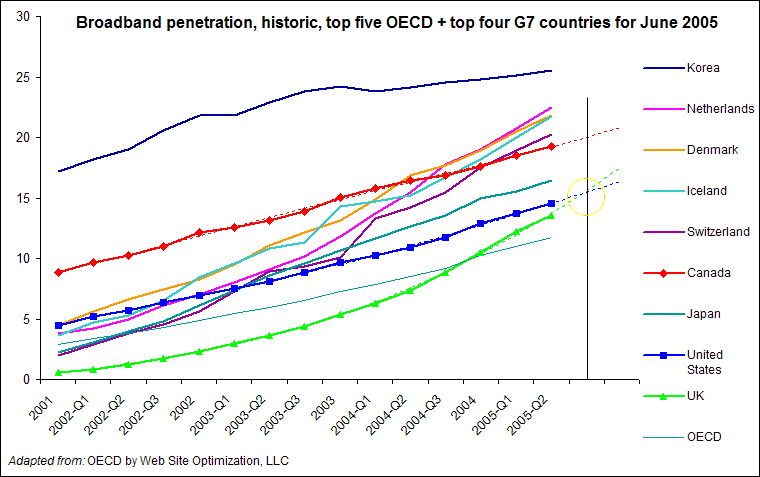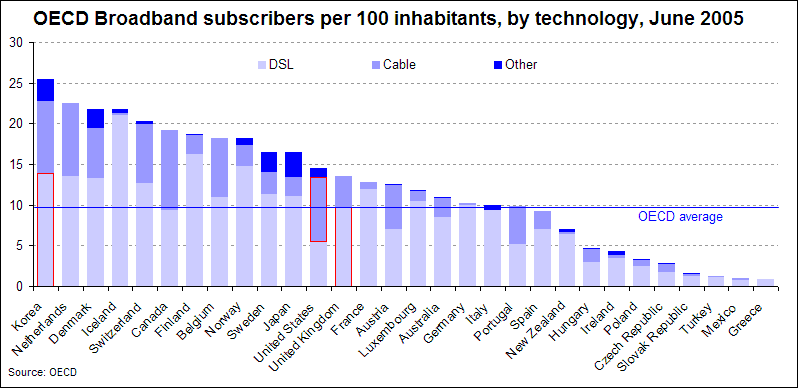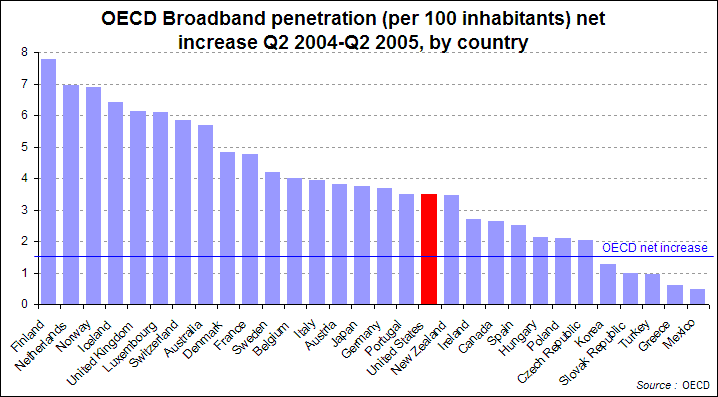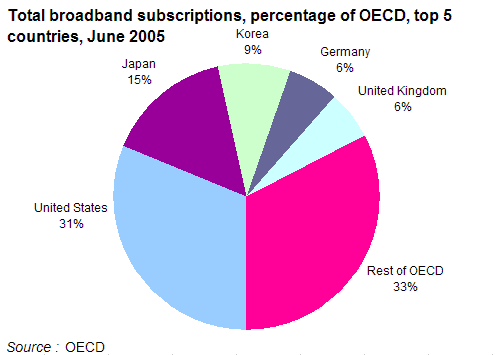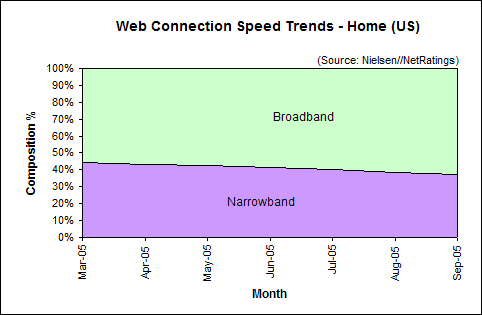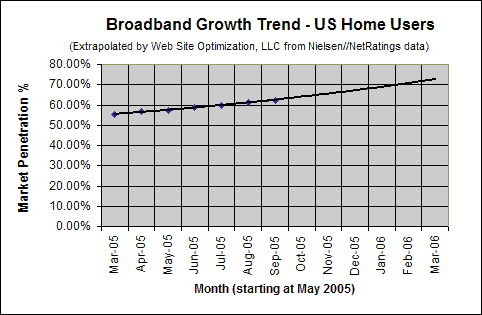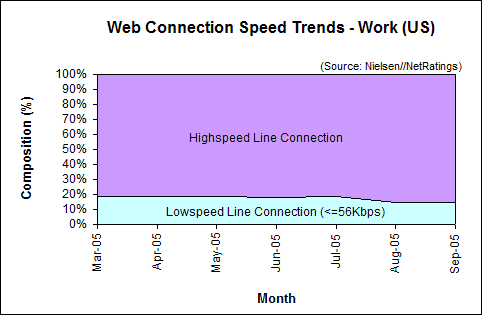UK broadband penetration passed the US on a per-capita basis in August 2005. The US continued its fall to 13th place among all OECD countries, according to our extrapolation of OECD survey data and Point Topic. However, the US leads all countries in total broadband subscribers, with twice that of Japan. Finland, the Netherlands, and Norway lead the pack in broadband penetration growth. US Broadband penetration climbed to 62.46% in September 2005, up 1.14 percentage points from 61.32% in August.
The charts below, derived from Nielsen//NetRatings and OECD data, show trends in connection speeds to the Internet for users in the United States and countries worldwide.*
UK leapfrogs US in Broadband Penetration on a per-capita basis
The US is now in 13th place overall in broadband penetration after being passed by the UK in Q3 2005 (see Figure 1, an extrapolation of OECD data). The Times of London also reports that the UK has passed the US in broadband penetration per 100 inhabitants in August 2005. The UK’s faster growth is likely due its adoption of predominantly DSL-based broadband and local loop unbundling versus the cable-dominated broadband mix of the US. The Times reports that other factors include more competition, lower prices and greater investment by telecoms and Internet companies in the technology. Note that for wired households, the US still holds a lead over the UK in broadband penetration of 62.5% vs. 55.7%, according to statistics from National Statistics UK and Nielsen//NetRatings.
Historic Broadband Penetration by Country 2001-2005
Figure 1: Historic Broadband Penetration by Country 2001-2005 (per 100 inhabitants)
Source: OECD.org (data used with permission)
US Falls to 12th in Broadband Penetration among OECD Countries in June 2005
The United States fell to 12th place in broadband penetration among countries surveyed by the OECD in October. As of June 2005, the US was 12th overall in broadband penetration per 100 inhabitants, down from 11th place in June 2004 (see Table 1 and Figure 2).
|
|
Broadband Subscribers per 100 Inhabitants – OECD Countries
Figure 2: Broadband Subscribers per 100 Inhabitants – OECD Countries
Source: OECD.org (data used with permission)
Note that while cable dominates the US broadband mix, DSL dominates the OECD and all countries with higher penetration rates (see Figures 2 and 3).
OECD vs. US Broadband Subscriptions by Technology (DLS, Cable, Other)
Figure 3: OECD vs. US Broadband Subscriptions by Technology
Source: OECD.org (data used with permission)
Finland Leads all OECD Countries in Broadband Growth
Finland has the highest broadband penetration growth of all countries surveyed by the OECD. Finland overtook the Netherlands in broadband penetration growth in June 2005 over the last OECD survey in December 2004. From Q2 2004 to Q2 2005, Finland added 7.76 broadband subscribers per 100 inhabitants, while the Netherlands added 6.97, Norway 6.89, Iceland 6.41, and the UK added 6.11 subscribers. The US added 3.48 broadband subscribers per 100 inhabitants, less than half that of Finland. The UK’s recent strong growth rate pushed it past the US for broadband penetration uptake per 100 inhabitants (see Figure 1 and Figure 4).
Broadband Penetration Growth per 100 Inhabitants – OECD Countries
Figure 4: Broadband Penetration Growth per 100 Inhabitants – OECD Countries
Source: OECD.org (data used with permission)
US Leads all Countries in Broadband Subscriptions
The US leads all countries in the total number of broadband subscriptions, with 31% of all OECD subscriptions, double that of its closest rival Japan with 15% (see Figure 5). Korea follows with 9%, German at 6%, and the UK has 6% of all OECD broadband subscriptions.
Percentage of Broadband Subsciptions, Top 5 OECD Countries
Figure 5: Percentage of Broadband Subscriptions, Top 5 OECD Countries
Source: OECD.org (used with permission)
Home Connectivity in the US
US broadband penetration grew to 62.46% in September among active Internet users. Narrowband users (56Kbps or less) now comprise 37.54% of active Internet users, down 1.14 percentage points from 38.68% in August 2005 (see Figure 6).
Web Connection Speed Trends – Home Users (US)
Figure 6: Web Connection Speed Trends – Home Users (US)
Source: Nielsen//NetRatings
Broadband Growth Trends in the US
In September 2005, broadband penetration in US homes rose 1.14 percentage points to 62.46% up from 61.32% in August. This increase of 1.14 percentage points is near the average increase in broadband of 1.19 points per month over the last five months. At the current growth rate of over 1.1 percentage points per month, broadband penetration among active Internet users US homes should break 70% by mid-January of 2006 (see Figure 7).
Broadband Adoption Growth Trend – Home Users (US)
Figure 7: Broadband Adoption Growth Trend – Home Users (US)
Extrapolated from Nielsen//NetRatings data
Work Connectivity
Most workers in the US enjoy high-speed connections to the Internet. Most use a high-speed line such as a T1 connection, and share bandwidth between computers connected to an Ethernet network. The speed of each connection decreases as more employees hook up to the LAN. As of September of 2005, of those connected to the Internet, 85.09% of US users at work enjoy a high-speed connection, down 0.37 percentage points from the 85.46% share in August. At work, 14.91% connect at 56Kbps or less (see Figure 8).
Web Connection Speed Trends – Work Users (US)
Figure 8: Web Connection Speed Trends – Work Users (US)
Source: Nielsen//NetRatings
Further Reading
- Broadband Use in UK surpasses US levels
- Britons have leapfrogged Americans in broadband access for the first time, according to the Times of London. Point Topic found that in the second quarter of 2005 broadband penetration in Britain overtook that of the US. There were 14 broadband connections per 100 Britons in August, compared with 13 in the US. Sept. 22, 2005.
- National Statistics UK Internet Connectivity Survey
- This August 2005 survey of UK ISPs shows broadband penetration at 55.7% of all online subscriptions, up from 54.3% in July 2005. From National Statistics UK. Note that in light of this and other recent data last month’s report appears to report too high a figure for UK broadband penetration.
- Nielsen//NetRatings
- Provides the US broadband data (percentage of active Internet users) for the Bandwidth Report.
- OECD Broadband Statistics
- October 2005 report shows June 2005 broadband penetration data for OECD (Organisation for Economic Co-operation and Development) countries.
- Point Topic World Broadband Maps Q2 2005
- Data maps showing different measures of broadband, DSL and cable growth and penetration for countries surveyed worldwide. Point Topic, Oct. 13, 2005.
*Note that Nielsen//NetRatings new NetSpeed report differs from the previous Web connection data in two ways. First NetSpeed determines the connection speeds of the Digital Media Universe, which combines Web traffic, Internet applications and proprietary channels. The old Web connection data was based solely on Web traffic. The other difference is that the old Web connection data was based on panelists where the linespeeds are known. Since linespeeds don’t change often, if a panelists has an unknown linespeed, their previous month’s speed is taken.
The Bandwidth Report is featured monthly on URLwire – news of useful and unique web content since 1994.

